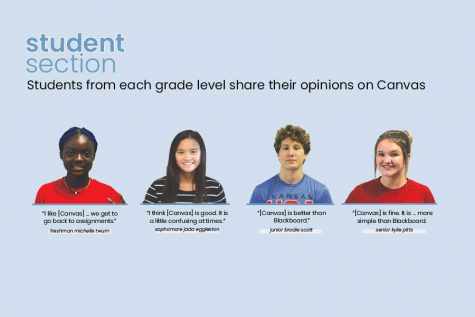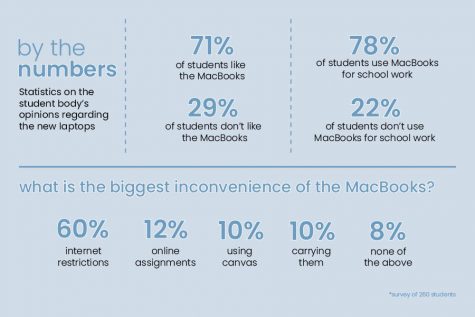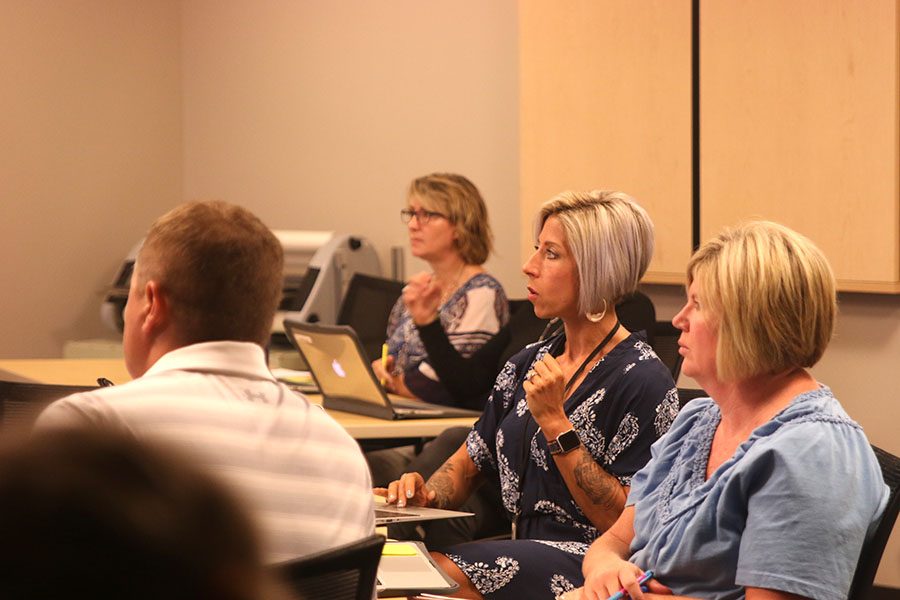By Hannah Chern
During the Apple Classroom training on Thursday, Aug. 29, K12 instructional specialist Rachel Mikel guides teachers through the various functions of Apple Classroom.
Students and teachers adapt to MacBooks in the classroom
September 18, 2019
The introduction of MacBook Airs, the chosen device for one-to-one computing in the district’s high schools, and Canvas, the district’s new course management system, has caused drastic changes within the classroom. The combination of new technology and electronic teaching methods have changed the way students learn, interact and demonstrate knowledge.
District technology specialist Cindy Swartz is optimistic about the opportunities the MacBooks open up in the classroom.
“The Apple products make it easy for teachers and students to collaborate, share and monitor devices,” Swartz said. “We are providing students with more tools to engage in learning and more technology-oriented experiences.”
Junior Adam White, who has seen firsthand the effect of the new devices in the classroom, believes the MacBooks have been an overall positive addition.
“I think [the MacBooks are] helpful in bringing technology to the school, bringing a level playing field and allowing teachers to use [technology] more effectively instead of spending 20 minutes getting computers or finding a computer cart,” White said.
However, White expressed frustration with his MacBook’s inability to successfully run everyday programs throughout the first few weeks of school.
“Specifically for my MacBook, it doesn’t run Microsoft Word or Google Docs very well, which isn’t great for taking notes or doing anything,” White said. “When simple applications like that can’t be run, the MacBooks are kind of useless.”

K12 District Instructional Specialist Rachel Mikel predicts that internet connection issues like White’s could be occurring due to the overload of electronic device users on the new network infrastructure – the result of one-to-one computing.
“The issue is [that] we have this many devices in a building [with a] new infrastructure,” Mikel said. “Right now, it’s a matter of [if] the current infrastructure with the network can handle the amount of traffic that we have now in each building with everybody having a device running. It may just be as simple as we need more access points in the buildings.”
White observed another important MacBook connectivity issue that has impacted students and teachers.
“I’ve seen MacBooks that can’t connect to [Apple] Classroom, which is really difficult for teachers who rely on Apple Classroom,” White said.
According to Mikel, the K12 technology help desk has identified this problem and is working on a solution.
“[The Apple Classroom difficulty] seems to be more focused at Mill Valley, so we’re trying to determine whether it’s your building and if it has anything to do with the construction or if it’s a network issue,” Mikel said. “We need to determine where that technical breakdown is happening before we can solve the problem. The good news is that we’re aware that that’s going on in your building, and that’s the first step. Now we can try to problem solve.”
On the other hand, the MacBooks have come with many benefits to counterbalance the negatives. Specifically, White appreciates the advantages of a fully digital classroom via the integration of Canvas.
“[Canvas] makes it a lot easier to not have to bring four textbooks home, especially [when] all the articles and all the papers that you need to do are online,” White said. “[Canvas] makes it nice and easy and all in one place. If you forget something at school, you can still do it because you will always have your MacBook or access to internet.”

Social studies teacher Jeff Wieland has taken full advantage of the digital classroom. All his class materials exist digitally, and his classes take place nearly entirely on MacBooks, using Canvas and Google applications.
Wieland has fully accepted that education is going to be an increasingly technology centered experience and therefore chooses to utilize it in his own classroom.
“I’ve tried to adapt my entire curriculum,” Wieland said. “If the 21st century version of learning is going to be [students] doing things online and looking [at] and accessing documents online and working together, I might as well embrace that.”
The implementation of one-to-one devices in the classroom has allowed Wieland to explore technological opportunities he could once only imagine.
“I think being able to collaboratively work on Google Docs and knowing that each kid can [participate has made an impact]. We can collaboratively work on the same document as a class,” Wieland said. “[One-to-one technology] allows me to experiment with things I always thought could be done, but we didn’t have the technology to do.”
Junior Sofia Nicot believes Wieland’s online classroom is a refreshing change.
“We use the MacBooks for everything. We have all our documents pulled up on [Canvas], so we don’t have to print them off,” Nicot said. “We do all our assignments and work [online]. We can pull up the PowerPoint that he’s currently showing [the] class and look through it. It’s nicer [because] it’s easier to access.” “[One-to-one technology] allows me to experiment with things I always thought could be done, but we didn’t have the technology to do.” — social studies teacher Jeff Wieland
Canvas software streamlines Wieland’s grading process and brings many additional educational benefits.
“I like Speed Grader; I think it’s nice to be able to see the assignment right there. I like to be able to score the assignment and then be able to type comments… [Teachers] even have the ability to give you verbal feedback [with] the microphone. Instead of having to try to write … I think it’s easier for me to communicate what I want to communicate [via typing],” Wieland said. “I kind of flip right through them [on Canvas]… and I don’t lose assignments. They’re not stacks of paper I’m carrying home; everything is there. [Students] get more immediate feedback too because you don’t have to wait for [their] paper to be returned to [them].”
